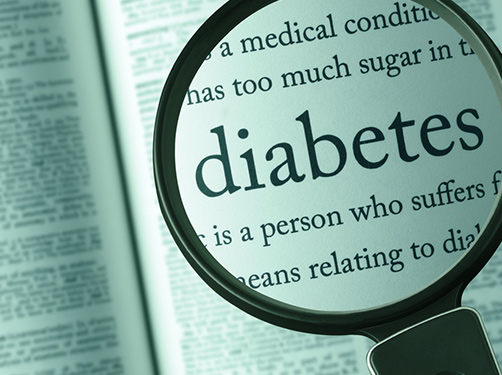The term diabetes mellitus covers various metabolic diseases that are associated with a permanently elevated blood sugar level. The most common form of diabetes is type 2 diabetes – around 93 percent of people affected have type 2 diabetes.
In addition to age and genetic predisposition, personal lifestyle plays a particularly important role in the development of type 2 diabetes. Type 1 diabetes, on the other hand, is an autoimmune disease. To date, the exact causes of type 1 diabetes are not fully understood and the disease cannot be cured.
On this page you will find the most important information on the risk factors and prevention of diabetes at a glance.
1. What is diabetes mellitus?
The term diabetes mellitus covers various diseases of the sugar metabolism. Basically, a distinction is made between type 1, type 2 and gestational diabetes. The main characteristic of all forms of diabetes is a permanently elevated blood sugar level.
The body needs the hormone insulin to take up the sugar (glucose) from food and transfer it from the blood into the cells. In case of diabetes, the pancreas either no longer produces any insulin (type 1) or produces too little and/or the insulin no longer works properly (type 2). This leads to elevated blood sugar levels. People with type 1 diabetes are dependent on insulin therapy for the rest of their lives. Lifestyle changes are the basic therapy for type 2 diabetes. In addition, blood sugar-reducing medication or insulin can be used to treat type 2 diabetes.
Gestational diabetes is associated with increased blood sugar levels during pregnancy. Blood sugar levels often return to normal after delivery. However, women with gestational diabetes have an increased risk of developing type 2 diabetes in the following years. Find out more about the risk factors that promote gestational diabetes here.
Permanently elevated blood sugar levels can lead to complications, for example of the eyes, kidneys, nerves and cardiovascular system. Early diagnosis and treatment of diabetes is therefore crucial for the further course of the disease.
Like cardiovascular disease and obesity, diabetes mellitus is a non-communicable disease.
Find more information about the different types of diabetes and living with diabetes on our “Living with diabetes” portal.
2. What increases the risk of type 2 diabetes?
Type 2 diabetes does not occur all of a sudden. The metabolic disease usually develops gradually over several years. A number of controllable and uncontrollable factors increase the risk of type 2 diabetes.
Risk factors that cannot be influenced include, for example, age, gender and genetic (family) predisposition. Lifestyle also plays a decisive role in the development of type 2 diabetes:
- High-calorie, low-fiber diet
- Lack of physical activity in one’s daily routine
- Overweight or obesity – especially in the deep abdominal fat tissue
- Alcohol
Lifestyle changes can actively influence these risk factors and reduce the risk of type 2 diabetes. In addition, a comprehensive change in lifestyle can also reverse existing type 2 diabetes – at least temporarily. In this context, experts speak of a remission.
3. What is my risk of developing type 2 diabetes?
The risk factors can be used to estimate the individual risk of developing type 2 diabetes. The DIfE’s German Diabetes Risk Score is a scientifically tested and recognized questionnaire for determining type 2 diabetes risk.
The risk score can be used to determine the personal risk of developing type 2 diabetes within the next 10 years. The questionnaire is intended for adults who have not been diagnosed with type 1 or type 2 diabetes at the time of testing.
In addition to the calculated individual type 2 diabetes risk, the Diabetes Risk Score shows which lifestyle factors already have a positive effect on the risk of diabetes and which parameters can still be actively influenced to reduce the risk. People at increased risk can often prevent or at least delay the onset of the disease by changing their lifestyle.
Test your risk of developing type 2 diabetes within the next 10 years.
4. What can I do to prevent type 2 diabetes?
If an increased risk of developing type 2 diabetes has been identified, this does not automatically mean that the metabolic disease will actually break out. Even small lifestyle changes can relieve the sugar metabolism and thus prevent or at least delay the development of type 2 diabetes. Even if prediabetes – the preliminary stage of type 2 diabetes – is already present, lifestyle changes can often prevent the development of type 2 diabetes.
The basis for a healthy lifestyle is a balanced and healthy diet and regular physical activity. Start with small steps! For example, try to eat 5 portions of fruit and vegetables a day and incorporate as much physical activity as possible into your daily routine. Take the bike more often or walk to get things done. This also has a positive effect on your body weight and contributes to weight loss if you are already overweight.
A healthy lifestyle not only prevents type 2 diabetes, but also other metabolic diseases such as obesity, high blood pressure and cardiovascular diseases as well as fat metabolic disorders.
Find more information about what you can do to reduce your risk of type 2 diabetes here.
5. What increases the risk of type 1 diabetes?
Type 1 diabetes is an autoimmune disease that usually occurs in children and adolescents. The exact causes are still not fully understood. What is known is that type 1 diabetes or the predisposition to the disease can be inherited. It is also assumed that environmental conditions such as certain infections or nutritional factors promote the development of type 1 diabetes.
Various screening tests can be used to identify children and adolescents with an increased risk of type 1 diabetes at an early stage. This can help to prevent severe metabolic decompensation at the onset of the disease.
6. Diabetes fact check: What do the terms prediabetes and insulin resistance mean?
Type 2 diabetes is the most common form of diabetes. In Germany, more than 8.7 million people have type 2 diabetes. Years before type 2 diabetes develops, people usually already have undetected prediabetes. This is a preliminary stage of type 2 diabetes. This means that blood sugar levels are already elevated, though not yet high enough to be classified as diabetes by experts.
People with prediabetes have a greatly increased risk of developing type 2 diabetes over time. However, this process can be prevented by a change in lifestyle.
Insulin resistance means that the effect of the hormone insulin is limited. The sensitivity of the body cells’ reaction to insulin is reduced, which means that they take up less sugar from the blood. In the long term, insulin resistance can lead to prediabetes and even type 2 diabetes.
In addition to elevated blood sugar levels, insulin resistance is often associated with an increased risk of cardiovascular diseases such as high blood pressure, overweight or obesity and fat metabolic disorders. The simultaneous appearance of these symptoms and/or clinical pictures is referred to as metabolic syndrome.
Find more information about prediabetes and insulin resistance as well as other facts about diabetes here.
Sources:
Achenbach, P.: Risiko für Typ-1-Diabetes auch bei Nachkommen erhöht? In: MMW Fortschritte der Medizin, 2022, 164: 67-69
Bundesärztekammer et al.: Nationale Versorgungsleitlinie Typ-2-Diabetes. Langfassung. Version 3.0. 2023
Bundesärztekammer et al.: Nationale Versorgungsleitlinie Therapie des Typ-2-Diabetes. Langfassung. 1. Auflage. Version 4. 2014 (Gültigkeit abgelaufen)
Deutsche Diabetes Gesellschaft: S3-Leitlinie Therapie des Typ-1-Diabetes. 2. Auflage. 2018
Deutsche Diabetes Gesellschaft et al.: S3-Leilinie Gestationsdiabetes mellitus (GDM) - Diagnostik, Therapie und Nachsorge. Langfassung. 2. Auflage. 2018
Fritsche, A. et al.: Different Effects of Lifestyle Intervention in High- and Low-Risk Prediabetes: Results of the Randomized Controlled Prediabetes Lifestyle Intervention Study (PLIS). In: Diabetes, 2021, 70: 2785-2795
Harreiter, J. et al.: Diabetes mellitus – Definition, Klassifikation, Diagnose, Screening und Prävention (Update 2023). In: Wien Klein Wochenschr, 2023, 135: S7-S17
James, D. E. et al.: The aetiology and molecular landscape of insulin resistance. In: Nat Rev Mol Cell Biol, 2021, 22: 751-771
Pleus, S. et al.: Definition, Klassifikation, Diagnostik und Differenzialdiagnostik des Diabetes mellitus: Update 2023. In: Diabetol Stoffwechs, 2023, 18: S100-S113
Landgraf, R. et al.: Therapie des Typ-2-Diabetes. In Diabetol Stoffwechs, 2023, 18: S162-S217
Mühlenbruch, K. et al.: Update of the German Diabetes Risk Score and external validation in the German MONICA/KORA study. In: Diabetes Res Clin Pract, 2014, 104: 459-466
Paprott, R. et al.: Validation of the German Diabetes Risk Score among the general adult population: findings from the German Health Interview and Examination Surveys. In: BMJ Open Diabetes Res Care, 2016, 4: e000280
Schiborn, C. et al.: German Diabetes Risk Score for the Determination of the Individual Type 2 Diabetes Risk. In: Dtsch Arztebl Int, 2022, 119: 651-657
Schulze, M. B. et al.: An Accurate Risk Score Based on Anthropometric, Dietary, and Lifestyle Factors to Predict the Development of Type 2 Diabetes. In: Diabetes Care, 2007, 30: 510-515
Wagner, R. et al.: Pathophysiology-based subphenotyping of individuals at elevated risk for type 2 diabetes. In: Nature Medicine, 2021, 27: 49-57
Ziegler, A. G. et al.: Primary prevention of beta-cell autoimmunity and type 1 diabetes – The Global Platform for the Prevention of Autoimmune Diabetes (GPPAD) perspectives. In: Mol Metab, 2016, 5: 255-262
Zorena, K. et al.: Environmental Factors and the Risk of Developing Type 1 Diabetes-Old Disease and New Data. In: Biology, 2022, 11: 608
As of: 07.05.2024







